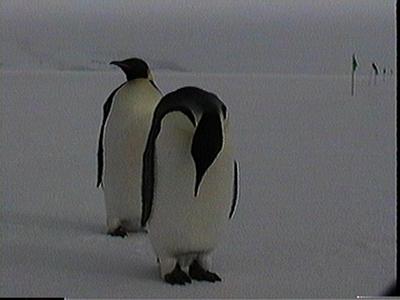
|
|
9 December, 1996
I'd like to share a few pictures with Paces Penguin Patrol, a group of
third graders from Forbes School in Torrington. They are interested in
learning more about the strange birds that live around the continent. As
often as I get to see penguins, I still enjoy interrupting work to kneel
down to watch them. If I'm very still, they will walk over to me to see what
I'm doing. They are very curious and have no fear of humans. Their only
predators are in the water, they must feel safe when they are on land.
I've encountered two species, the Adelie and the Emperor. One of our
experiments is near an Adelie rookery. When we first started going there,
they were in the process of building nests. The males would collect small
pebbles and arrange them for a shelter where two eggs would be laid.
Occasionally one bird would steal a pebble from another nest, a loud
skirmish would break out and occasionally a serious fight would ensue.
Yesterday I noticed that all the eggs seemed to have been laid and the birds
were quietly incubating them. The population of the colony had drastically
changed. Half of the penguins, the females, had returned to the ocean to
feed. The males will have to wait for several weeks until their partners
return to assume the brooding duties.
One the way back to McMurdo, we came upon a lone Emperor about twenty miles
from the ice edge. It was walking south, away from its source of food. The
Emperors have a different season for breading. Their eggs are laid in May or
June, early winter in Antarctica. The males will shelter a single egg for 60
to 65 days at a time when the temperatures reach as low as seventy degrees
below zero. If they were to leave, the eggs would freeze. They must spend
that time without eating! It doesn't sound like a fun way to spend the
winter, however, there are no predators to steal the eggs. This strange
behavior helps to ensure the survival of the species.

These emperor penguins were twenty miles from the ice edge

These Adelies were fighting over a stone
Contact the TEA in the field at
.
If you cannot connect through your browser, copy the
TEA's e-mail address in the "To:" line of
your favorite e-mail package.
|
